Elite NJ Offshore Fishing | Reel Altercation
- Published Date: July 18, 2025
- Fishing
- Barnegat Light
- $475 - $1,950 price range
- Updated Date: September 14, 2025
Summary
%2F%2Fusers%2Faa5523c7-0c5c-4f78-912c-be69fe56c86c%2Fratecard%2Fimage46.png&w=1200&q=75)
Offshore Bounty


Tuna, Mahi, and Deep-Sea Bass: The Ultimate Offshore Adventure
Hey there, anglers! Ready for the fishing trip of a lifetime? We're talking about an action-packed day off the coast of Barnegat Light that'll have you telling stories for years to come. This isn't your average day on the water - we're going after the big boys. Tuna, mahi-mahi, and jumbo sea bass are all on the menu, and trust me, your arms will be feeling it by the end of the day. But that's what we're here for, right?
What's the Game Plan?
Alright, here's how we roll on this extended full-day trip. We'll start by heading out about 30 miles offshore - that's where the real magic happens. Early morning is prime time for tuna, so we'll kick things off with some jigging action. As the sun climbs higher, we'll switch gears and start trolling. This one-two punch gives us the best shot at hooking into some serious fish. And if the mahi are running? You bet we're going to do some pot hopping. It's like a treasure hunt, but instead of gold, we're after those beautiful, acrobatic fish. On the way back, we'll hit some deep-water wrecks for monster sea bass. It's a full day of non-stop fishing action, tailored to what's biting and where they're hiding.
Techniques That Put Fish in the Boat
Listen up, because this is where the rubber meets the road - or in our case, where the lure meets the fish. We're not messing around with light tackle here. For tuna, we're talking heavy-duty jigging rods and reels spooled with braided line. When we switch to trolling, we'll be setting out a spread of lures and maybe even some live bait if the conditions are right. For mahi, it's all about sight fishing around floating debris or weed lines. And those sea bass? We'll be dropping some serious hardware down to the wrecks - think heavy sinkers and stout rods. It's a workout, but man, is it worth it when you feel that thump and the rod doubles over. Just remember, when I yell "Fish on!" - that means it's go time!
Target Species
Mahi Mahi, or as we sometimes call 'em, dorado, are like the acrobats of the ocean. These guys are known for their spectacular aerial displays when hooked. They're fast growers and can reach up to 30 pounds in their first year. The best time to target them is mid-summer when they follow the warm Gulf Stream waters. Mahi are not just a blast to catch; they're also some of the best-eating fish out there. Their firm, white meat is perfect for grilling or searing.
Yellowfin Tuna are the marathon runners of the sea. These torpedo-shaped fish can grow over 200 pounds and are known for their long, screaming runs that'll test both your gear and your stamina. We typically start seeing them in late spring, with the action peaking in summer. There's nothing quite like the fight of a yellowfin - it's why so many anglers get hooked on offshore fishing.
Little Tunny, also known as false albacore or "albies," might be smaller than their yellowfin cousins, but don't let that fool you. These speed demons can make your reel sing like nothing else. They typically show up in late summer and fall, often in large schools that can create epic topwater blitzes. Pound for pound, they're some of the hardest fighting fish in the ocean.
Bluefin Tuna are the prize fighters of the Atlantic. These giants can top 1,000 pounds, though the ones we typically encounter are in the 100-300 pound range. Bluefin season usually kicks off in June and can run through fall. Landing one of these beasts is a true test of an angler's skill and endurance. It's the kind of fish that can make your whole season.
Black Sea Bass might not have the size of tuna, but what they lack in weight, they make up for in numbers and taste. These bottom-dwellers hang around wrecks and reefs, and when you find them, it's often non-stop action. The bigger ones, which we call "knuckleheads," can push 5 pounds or more. They're available year-round, but the bigger ones tend to move offshore in the summer, which is perfect for our deep-water stops on the way in.
Why Anglers Keep Coming Back
Let me tell you, there's something special about fishing these waters. Maybe it's the way the sun rises over the Atlantic as we're heading out. Or that moment when a school of tuna starts busting on the surface, and everyone scrambles to get their lines in the water. It could be the satisfaction of filleting your catch at the end of the day, knowing you've got some world-class sushi-grade tuna or mahi for dinner. Whatever it is, it keeps folks coming back year after year. And with only 3-4 spots available on each trip, you're guaranteed a personalized experience. No cattle boats here - just you, a few other anglers, and a whole lot of ocean to explore.
Time to Get Your Fish On
Alright, let's cut to the chase. If you're reading this, you're probably already imagining yourself out there, rod in hand, battling with a big tuna or mahi. So why wait? This trip is the real deal - a full day of offshore action that'll satisfy both newbies and seasoned salts alike. We've got the knowledge, we've got the gear, and we've got the hotspots dialed in. All we need is you. So grab your sunscreen, pack some snacks (trust me, you'll work up an appetite), and let's make some fishing memories that'll last a lifetime. Book your spot now, and get ready for a day on the water you won't soon forget. The fish are waiting - are you ready to meet them?
Learn more about the animals
Black Sea Bass
## Black Sea Bass Fish Species (Centropristis Striata) ## Fish Description Black Sea Bass is a member of the Grouper family. They are plump-bodied with an extended pelvic and dorsal fin. The dorsal fin comes with a soft rayed rear section and a spiny forward section, marked with a sequence of white spots and bands. Their body color is gray to black, but the center of the scales is white. During the spawning season, males can turn bright blue in color and have a large hump on their heads. Juveniles are brown and have a dark stripe running down the body. ## Fish Size The Black Seabass can reach about 25 inches in length; weigh more than 8 pounds, although most of them caught is less than 4 pounds in weight. The Black Sea Bass world record catch is 10 lb 4 oz. and was caught in Virginia Beach, January 2000. ## Fun Facts About Black Sea Bass Up until recently, the furthest north the black bass was found was Massachusetts. Because of the warming climate, the bass has ventured up to the Gulf of Maine where the water temperatures have increased over the years. They are born as females then change to males. This generally happens when they reach 9 - 13 inches Social interaction can play a big role in this sex reversal. The removal of the big male from the Black Sea Bass population may cause one or more of the remaining bigger females to change sex and play the male role. The female Black Seabass normally matures at the age of 2 to 5 years and produces about 280,000 pelagic eggs. ## Fish Diet Adult and juvenile Black Sea Bass feed on a variety of invertebrates such as hermit crabs, rock crabs, squid, and razor clams. ## Distribution and Habitat 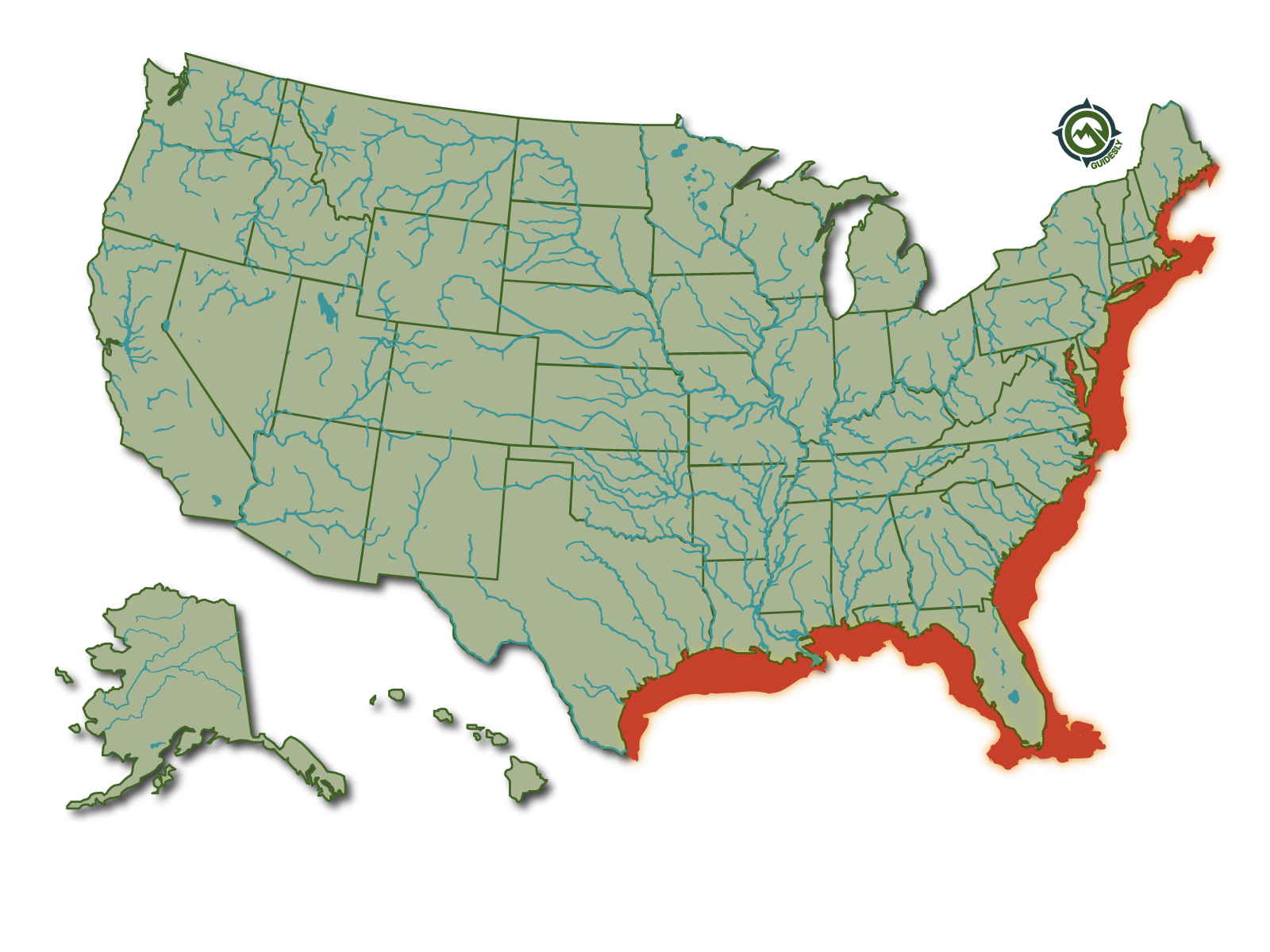 ## Fishing Method The best time to fish for Black Sea Bass is from late spring to summer when they congregate close to the shore. Underwater structures like jetties, piers, and wrecks, is where you will be likely to find them. The bigger males will be found in deeper water and a rocky bottom. The Black Seabass will put up a good fight until it breaks water. A medium-weight rod that's 6-8 feet long with a reel with a 20-30 pound fused, mono or braided line will be successful. They are mostly bottom feeders although they will occasionally strike at jigs, plugs, and lures including a 2 hook bait rig. Live bait such as squid or fish strips is a very good method. The Federal Recreational Black Sea Bass season is February 1 through 28, and May 15 through December 31. ## Habitat During the summer months, they will gather around sunken wrecks, rocky bottoms, old pilings, and wharves and are most abundant at depths of less than 120 feet. Juvenile seabass tend to prefer estuaries where they feed and avoid predators. During the winter months, they migrate to the more south Atlantic states and offshore. ## Distribution Black Seabass are found on the US eastern seaboard from the Gulf of Maine to the Florida Keys and then to the Gulf of Mexico.

Bluefin Tuna
Bluefin Tuna (Thunnus Thhynnus) Description
The Atlantic Bluefin Tuna is one of the largest, fastest, and most fantastically colored fishes. They are shiny blue on the top, shimmery silver/white on the bottom, and reddish rear fins. They can be easily distinguished from other tuna species because of their smaller pectoral fins. They have a pineal window on its head that helps them navigate a wide range of areas. This large fish has a streamlined, torpedo-shaped body that is built for speed and endurance.
Size
Atlantic Bluefin Tuna is the largest of its tuna family. Their average size is 6.5 feet in length and 550 pounds, although they can reach twice that size in both weight and length, a whopping 12 feet and 1400 pounds. The Pacific Bluefin Tuna is smaller, with its average size of 5 feet and 130 pounds.
Interesting Facts
Bluefin Tuna meat is regarded as the most delicious, particularly among sashimi eaters. Their demand and prices have soared over the last 30 years worldwide, especially in Japan. Commercial operations have found new ways to catch them causing overfishing causing the Bluefin Tuna population to plummet. There are international conservation efforts to save them, but illegal fishing in Europe is endangering this species.
The Bluefin Tuna hunts fish such as mackerel and herring. They also enjoy invertebrates like crustaceans and squid along with kelp and zooplankton. Their average speed is 43 mph, and they can dive as deep as 3,300 ft. Sharks and whales are occasional predators of young Bluefin Tuna.
Spawning
Atlantic Bluefin spawn in the Gulf of Mexico and spawning starts in April and ends in June. Up to ten million eggs are laid, and eggs hatch within 48 hours. They have broadcast spawning habits, which means a few males and females at the same time in the same water release sperms and eggs. This ensures maximum fertilization of eggs.
Habitat and Distribution
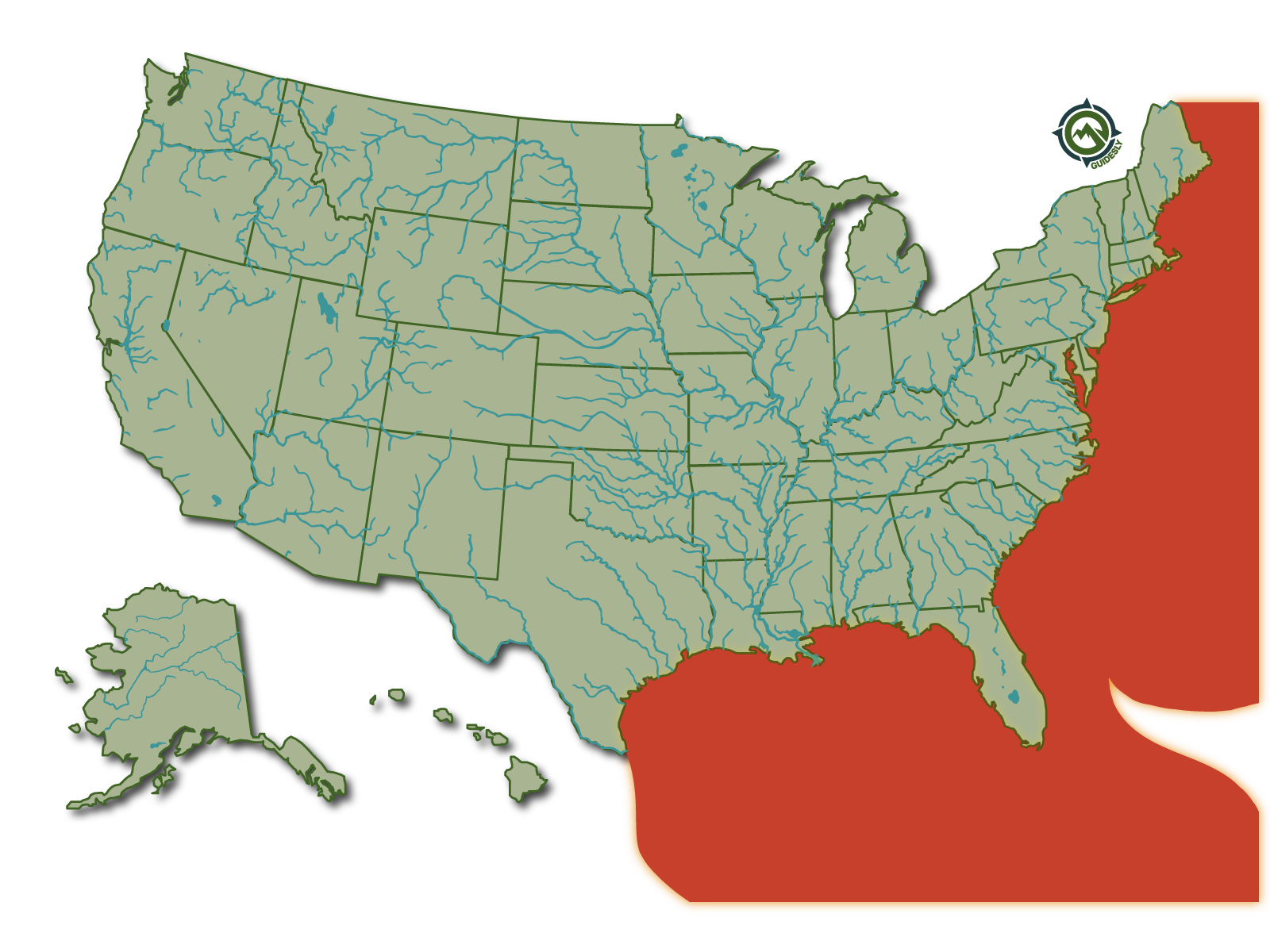
Bluefin Tuna is native to both the eastern Atlantic and the western Atlantic Ocean. These large fish are a highly migratory species found from New Foundland to the Gulf of Mexico. They are also native to the Mediterranean Sea and were populated in the Black Sea until they were fished to extinction. As they are a rare warm-blooded fish, they comfortably live in cold and tropical water.
Baits and Lures
If trolling for Bluefin, we suggest using small fish natural bait of herring as your first choice. Squid, mackerel, mullet, or whiting can also be used. If using a line, chumming will attract the tuna and use lures of cedar plugs, spoons, feathers, and poppers. Also helpful to use colors of blue or bone, black or silver.
Fishing Techniques - How to Catch Bluefin Tuna
These are strong fish and tough fighters. Be prepared for fast surface runs and deep dives. You will need the heaviest of tackles and a sturdy fishing belt. Some of the most effective techniques include using live bait, trolling with lures, and jigging. Live bait such as squid or mackerel will entice the bluefin tuna to bite, while trolling with lures can mimic the movement of their natural prey. Jigging involves dropping a lure to the bottom of the ocean and quickly reeling it back up, which can trigger the predatory instincts of bluefin tuna. Trolling is the way to find the school Bluefins as it lets you search and cover large areas. Use of outriggers and your tackle should consist of snap swivels so that anglers can swap the rigs easily. Note, they usually bite more aggressively during the evening and morning hours. Locate them near offshore islands, reefs, or deep-feeding areas.
Jigging and chunking are two of the most effective and widely-used techniques for catching bluefin tuna. With the ability to target specific depths and locations in the water column, anglers can increase their chances of success in catching these prized fish. However, it is important to note that these techniques require a certain level of skill and experience to execute properly. Furthermore, it is crucial to practice responsible fishing practices to ensure the sustainability of the bluefin tuna population. When implemented responsibly, these techniques can result in thrilling and rewarding experiences for anglers looking to catch the fish of a lifetime.
Is Bluefin Tuna Good to Eat?
Bluefin tuna has a succulent, fatty flavor that is best enjoyed in its purest form when served raw or lightly seared. This exquisite fish has a naturally delicious Umami taste that can be compromised with marinades or sauces. Bluefin sushi is the perfect way to savor the rich and buttery flavor of this fish. When crafting bluefin sushi, only the highest quality cuts are selected and carefully prepared to enhance their natural taste. Whether enjoyed as sashimi or in a maki roll, bluefin tuna is a delicacy that should be savored in all its unadulterated glory. Its melt-in-your-mouth texture and sweet, delicate flavor make it a favorite of sushi lovers worldwide. So next time you order bluefin tuna, consider opting for it raw or lightly seared to fully appreciate its natural taste.
Bluefin tuna is a type of fish that is considered a delicacy in many parts of the world for its rich and flavorful taste. However, the global population of Bluefin tuna has declined drastically in the past few decades due to overfishing and other environmental factors. This has made it difficult to sustainably harvest this fish, and has also led to concerns about the impact of Bluefin tuna consumption on the environment. Achieving sustainable bluefin tuna conservation means implementing strategies to ensure that bluefin tuna populations will continue to thrive and supply communities with a healthy and delicious source of food. This involves carefully monitoring fishing efforts and adopting fishing methods that minimize harm to the environment and other marine species. There is also a need for strict regulations and policies to prevent overexploitation of bluefin tuna populations. Despite these concerns, many people still enjoy eating Bluefin tuna for its delicious taste, and continue to seek out this fish as a special treat. While it is important to be mindful of the impact of our food choices on the environment, there is no denying that Bluefin tuna is a tasty and sought-after food that many people enjoy.
Regulations
The species is federally managed and requires obtaining a permit and reporting your catch NOAA Fisheries has put in place regulatory measures put in place to manage bluefin tuna bycatch in the pelagic longline fishery for Atlantic highly migratory species.

Little Tunny
Little Tunny (Euthynnus alletteratus) Description
The Little Tunny is a variant of tuna, known also as a Bonita, False Albacore, or Little Tuna (hence the nickname). Little Tunnies is also considered one of the smaller variants of tuna. Because of their size, one of the Little Tunny’s defense mechanisms includes going in schools and being migratory. As migratory fish, they usually head south during Winter or Fall.
The Little Tunny resembles a hybrid between a Skipjack Tuna, different species of mackerel, and an Atlantic Bonito. It appears quite small and has a fusiform body, looking more torpedo-shaped. This allows them less friction in water and makes them less tired as they migrate. It has a slight underbite with cone-shaped teeth lining with a small bone sticking out from the roof of the mouth. If you open its mouth, you’ll also notice that the Little Tunny’s tongue has two vertical lines for ridges.
Aesthetically, the Little Tunny has a rounded snout to lessen the water resistance. To prevent themselves from being picked off, their scales and skin are a dark metallic blue with dark blue-green stripes from the midpoint of their dorsal fin to their tail. They also have little, black fingerprint-looking spots on its body which distinguishes them from other fish such as the Atlantic Bonito.
Diet
The Little Tunny is carnivorous. They usually feast on small fish and small invertebrates which are clumped up together in groups. Another reason why Little Tunny travels in schools: because their preys are in schools, they usually swim around them in a school to gather them up. However, Little Tunnies are also okay in eating some cephalopods (i.e., squid) and crustaceans.
Little Tunny Size
The Little Tunny is usually measured by weight. Their average weight is around 10-12 lbs. Sometimes, they can even hit 20 lbs. The highest ever recorded was around 36 lbs.
Interesting Facts about the Little Tunny
- A Little Tunny only has a short lifespan of about 5 years.
- When tracking a Little Tunny, listen for sounds. Little Tunnies are quite noisy when they eat.
- Because its flesh is red, the Little Tunny isn’t always eaten.
- Most would confuse it for having red tide when in reality, its meat is very similar to that of a Yellowfin Tuna.
- Most people prefer white meat fish. However, when finding a Little Tunny, the redder the meat, the fresher it is.
- Little Tunny has stronger tasting meat over the usual tuna.
- Little Tunnies are strong swimmers. Be warned; they definitely can give you a good fight.
- Clean your Little Tunny well before eating! Especially in the stomach! Little Tunnies are known for housing many different kinds of parasites.
Little Tunny – Fishing Techniques: How to Fish for a Little Tunny
The Little Tunny is known for its hard, fighting spirit, making it a prized game fish. Asides from that, Little Tunnies are often fished out by anglers who are shooting for bigger prizes such as sharks and marlins.
The most common technique anglers use in fishing out a Little Tunny is via trolling. Since the Little Tunny travel in schools, anglers usually set up multiple fishing lines to catch them. They add ballyhoos and mullets while decorating it with some brightly colored feathers to attract them. However, Little Tunny won’t shy away from live bait. Some live baits they would prefer would be Bluefish or Pinfish.
Another recommended technique is Flyfishing. Using a lightweight bait, cast the line in the water. But don’t yank it! When flyfishing, you’re supposed to let the fish do the work for you. Any tugging and resistance might cause your line to snap.
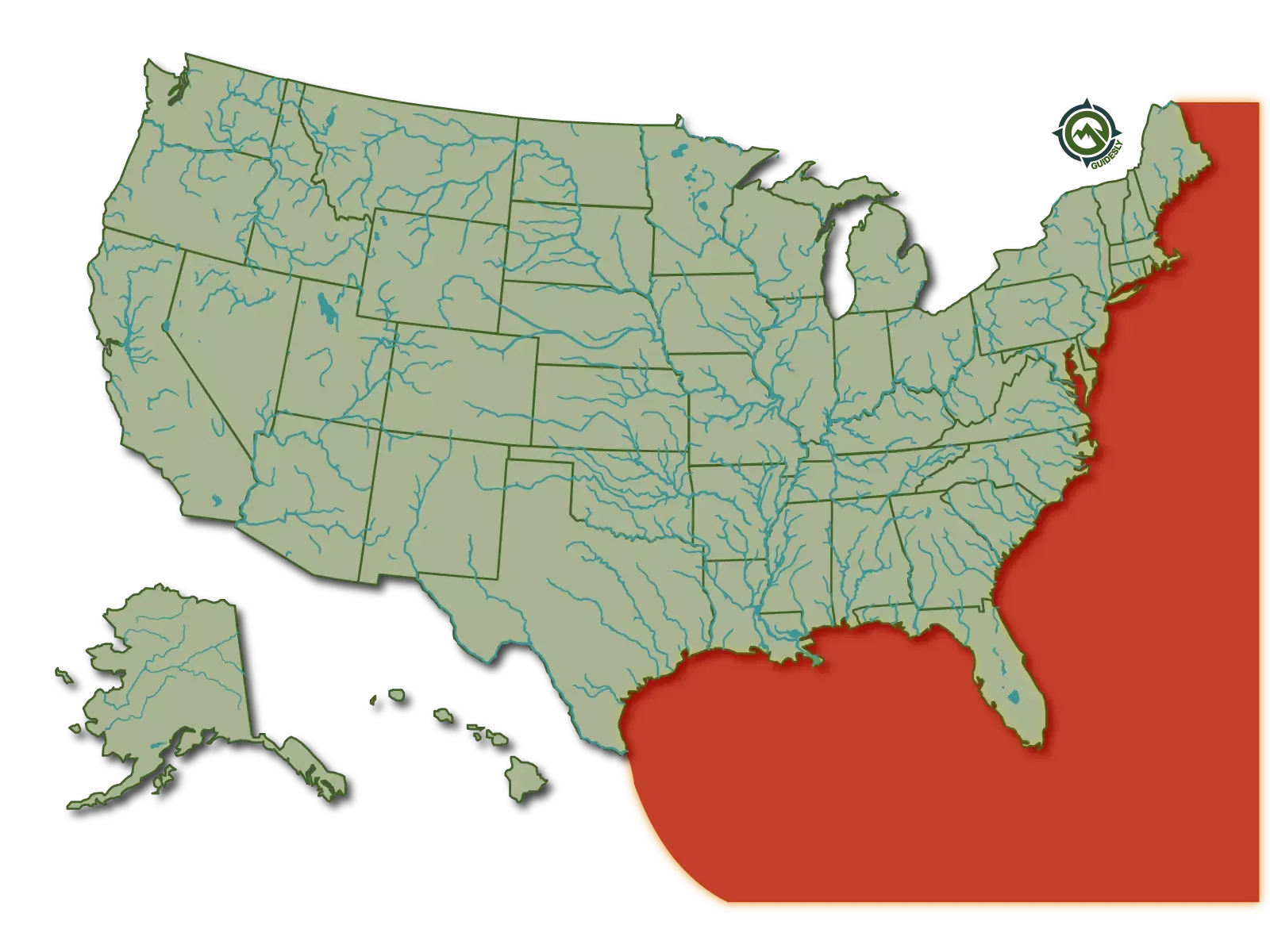
Little Tunny Habitat and Distribution
Little Tunny are pelagic fish and prefer warm to temperate waters. They like staying in nearshore waters, preferring to be near the surface. They sometimes loiter around in points, inlets, jetties, and sandbars. They sometimes swarm underneath the jetty especially if there’s a school of their prey swimming nearby.

Mahi Mahi or Common Dolphinfish
Mahi Mahi or Common Dolphinfish (Coryphaena hippurus) Fish Description
The Mahi Mahi or common dolphinfish, also known as the dorado, are distinctive because of the play of colors on their bodies. Their sides are golden, with splotches of bright blue and green on the back and sides, and pectoral fins a shimmering blue, and underwater they can boast a myriad of other colors depending on where the light hits. However, once taken out of the water, they change colors drastically like a light show, before finally fading to a silver or muted yellow-grey upon demise.

The head of this fish species is also quite distinct. It is characterized by a single dorsal fin that extends from the head to the tail or caudal fin. Male Mahi Mahi have a protruding head, while the female head looks a little more rounded.
The Mahi Mahi or common dolphinfish belong to the family Coryphaenidae, with the other one being the pompano dolphinfish. The juvenile common dolphinfish are often mistaken for the pompano as the latter are quite small. One way to distinguish them is to look at the pectoral fins. The pectoral fins of the common dolphinfish are longer compared to that of the pompano. They also differ in color once out of the water. The common dolphinfish will look a little more yellow, while the pompano will sport a more prominent silver.
Why are Mahi Mahi called Dolphin Fish?
The confusion over the name Mahi Mahi started in Hawaii. The answer to why lies in the history of the Hawaiian Islands where this fish species was first discovered. In Hawaii, mahi mahi means very strong or strong-strong and fisherman referred to the fish as Mahi Mahi. That phrase caught on and the fish went from Mahi to Mahi Mahi and sometimes spelt Mahi-Mahi. It is also referred to as "dorado," However, when mahi-mahi made its way to the US mainland, it was commonly referred to as "dolphin fish." This led to confusion among consumers who thought they were buying or eating meat from actual dolphins.
There are a couple of local stories as to how that happened. It is believed that early American fishermen visiting Hawaii heard locals referring to the fish as "mahi-mahi," mistook it for a reference to dolphins and started calling it "dolphin fish." A second theory suggests that mahi-mahi's long dorsal fin may be responsible for its common name. But the Mahi Mahi, Dophinfish, Dorado is not related to Dolphins in any way.
Why are Mahi Mahi called Dorado?
Mahi Mahi are also known as Dorado, which means golden in Spanish. This name is derived from their distinctive golden-yellow coloration, which is most prominent when the fish is removed from the water. When they are in the water, their coloration is more blue and green. The name Dorado is commonly used in Latin America, occasionally in Hawaii and is also used in other parts of the world where Spanish is spoken.
Is Mahi Mahi Good to Eat?
This fish is found in tropical and subtropical waters around the world and has become popular due to its mild taste and firm texture. But the question remains - is mahi mahi a good fish to eat? Yes, Mahi-Mahi is a popular food to eat, especially in coastal regions where it is readily available. It is a firm, white-fleshed fish that has a mild, sweet flavor, which makes it appealing to a wide range of tastes. It is also a versatile fish that can be prepared in a variety of ways, including grilled, baked, fried, or broiled. In many parts of the world, Mahi-Mahi is used as a substitute for other popular fish species such as tuna or swordfish. It is a healthy fish that is rich in protein, omega-3 fatty acids, and other important nutrients. Overall, Mahi-Mahi is a popular and delicious fish that is enjoyed by many people around the world.
When it comes to taste, many people enjoy mahi mahi because it has a mild flavor that isn't too overpowering. Its flesh is typically white with pinkish hues and has a slightly sweet taste compared to other types of fish. When prepared properly, it can be a flavorful and satisfying meal. Some people describe its flavor as being similar to that of swordfish or tuna, but with a slightly milder flavor profile. The versatility of Mahi-Mahi also makes it a popular choice for a range of cuisines, from Caribbean to Asian. Overall, if you enjoy seafood, there is a good chance you will find Mahi-Mahi to be a tasty and enjoyable fish to eat.
Mahi Mahi Size and Diet
The Mahi Mahi or common dolphinfish do not live long, with some reaching five years but rarely exceeding four. They, however, spawn all year long and mature quite quickly, making their population quite strong and stable. The average size for the Mahi-Mahi is 39 inches, weighing from 15 to 29 pounds. The Mahi-Mahi world record is 87 pounds.
The Mahi Mahi are carnivorous and are known as great swimmers, making them fantastic predators. They are not very particular with what they eat, though they do adapt as they mature. The juveniles of this fish species feed on crustaceans, while the adults focus on bony fishes. They are quite partial to the flying fish. They feed mostly during the day.
Interesting Facts About the Mahi Mahi or Common Dolphinfish
- This fish species mature quickly at three to four months. They practice broadcast spawning, a reproductive behavior wherein both females and males release their respective eggs and sperms into the same water column. This practice apparently guarantees a better chance of fertilization.
- Female Mahi Mahi spawn two to three times annually. In their lifetime, they can produce millions of eggs.
- Big consumers of this fish species: the United States and the Caribbean. The Japanese, Hawaiian, and Australian markets are also significant.
- If you're catching a Mahi-Mahi to eat, make sure to store it with lots of ice before you clean it. This serves two purposes: it keeps your fish fresh, and it makes cleaning much easier.
- The flesh of the Mahi-Mahi is similar to that of the swordfish. It tastes best pan-fried, grilled, roasted, or simmered in sauce. Because its flesh is firm, it is also good to cook it over wood or coal.
- The Mahi-Mahi is also has a small instance of ciguatera poisoning, which is caused when the toxins from Gambierdiscus toxicus are consumed by the fish accidentally and grow in their bodies through time.
Fishing Technique: How to Catch Mahi Mahi or Common Dolphinfish
The common dolphinfish are prized both as game fish and as commercial species. Anglers love fishing for them because they are quite stunning to look at and can also make great food.
When fishing for the common dolphinfish, one should look for an area that has a lot of floating debris by the edge of the reef, as this fish species are attracted to such. Also, anglers should keep a look out for frigate birds trolling any floating debris as they can take you to some big catch.
This fish species can be caught with trolling near weedlines, floating debris, and currents. If you choose to do so, make sure you employ the use of 30- to 50-pound class rods and reels. With trolling, you can use live bait (ballyhoo or squid are most recommended) or artificial lures. Make the bait skip on the surface of the water to excite the common dolphinfish (they love a good flying fish for their meal, after all).
The common dolphinfish are quite strong swimmers and are quite hard to reel in, so anglers will do well with an equally strong tackle, and perhaps another one for back-up just in case the one you're using breaks off while you're reeling this strong fish in.
Is a Mahi Mahi a Tuna?
No, Mahi-Mahi, also known as dolphin fish, is not a type of tuna. Mahi-Mahi is a species of fish in the Coryphaenidae family, while tuna belongs to the Scombridae family. Although both Mahi-Mahi and tuna are popular fish to eat, they have different characteristics and are not closely related. Mahi-Mahi has a mild and sweet flavor with a firm texture, while tuna has a more robust and meaty flavor with a soft and flaky texture. Additionally, Mahi-Mahi is typically found in warmer waters, while tuna can be found in a wider range of habitats.
Why is Mahi Mahi called Dolphin?
There has been some confusion regarding whether or not mahi mahi is a dolphin. Mahi-Mahi is sometimes referred to as a dolphin or more likely, a dolphin fish, because of its similar appearance to the mammal dolphin. While both species share similar physical characteristics such as their long dorsal fins and bright colors, they are distinctly different animals. Mahi mahi belongs to the Coryphaenidae family of fish, while dolphins belong to the Delphinidae family of mammals. However, it's important to note that Mahi-Mahi is not related to dolphins in any way.
It's important to clarify this misconception because many people avoid eating mahi mahi due to their belief that it's related to dolphins. In reality, consuming responsibly sourced and properly prepared mahi mahi can be a healthy and sustainable choice for seafood lovers.
Is Mahi Mahi Safe to Eat?
When it comes to questions about its safety as a food source, many people are left wondering whether it's safe to eat or not. In general, mahi-mahi is considered safe to consume, but there are some risks associated with eating this fish that must be taken into account.
One of the main concerns regarding mahi-mahi consumption is the risk of ciguatera. Ciguatera is a type of food poisoning caused by eating fish that have consumed toxic algae. Mahi-mahi can be a carrier of this toxin if they have eaten smaller reef fish that were contaminated with ciguatoxins. Symptoms of ciguatera include vomiting, diarrhea, and neurological symptoms such as tingling sensations in the fingers and toes. While ciguatera is most commonly associated with reef fish such as barracuda and snapper, it can also affect pelagic species like mahi mahi.
Where do Mahi Mahi Live? Habitat and Distribution
This surface-dwelling fish species are typically found under floating objects. Sometimes those floating objects are floating sargassum, and sometimes they can even be ships.
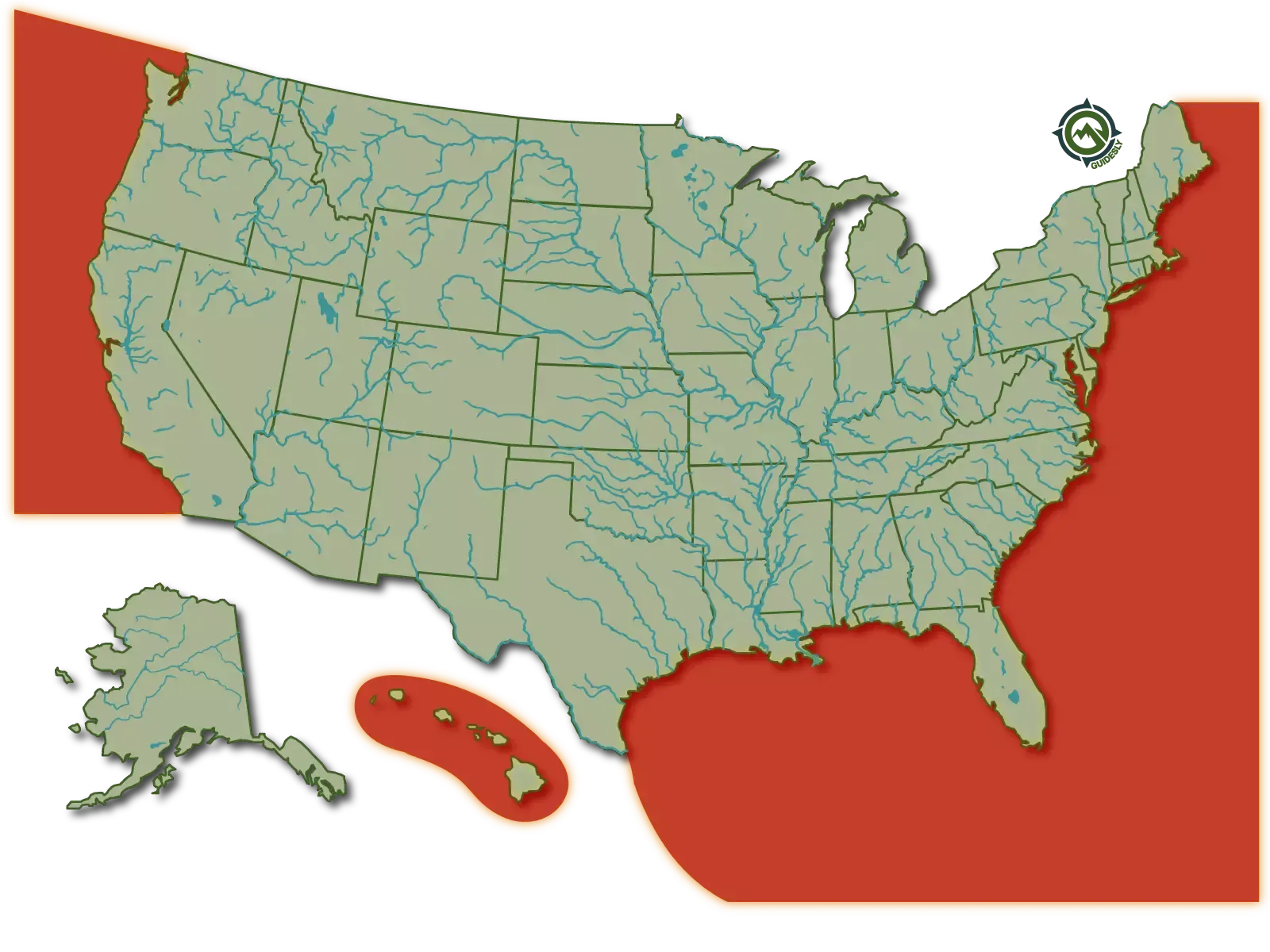
The common dolphinfish are found worldwide in warm and temperate waters, distributed along the Atlantic, Pacific, and Indian Oceans. They occur in both the western parts (particularly the Sea of Japan, around the Philippine Islands, and Taiwan) and eastern parts (from the Oregon and Californian coasts to Peru) of the Pacific Ocean. In the warmer waters of Southern California, their population is quite abundant, particularly in Newport Beach San Diego, Long Beach, and Dana Point. In the Atlantic coast, they are found in Florida, particularly Miami, West Palm Beach, and the Keys.
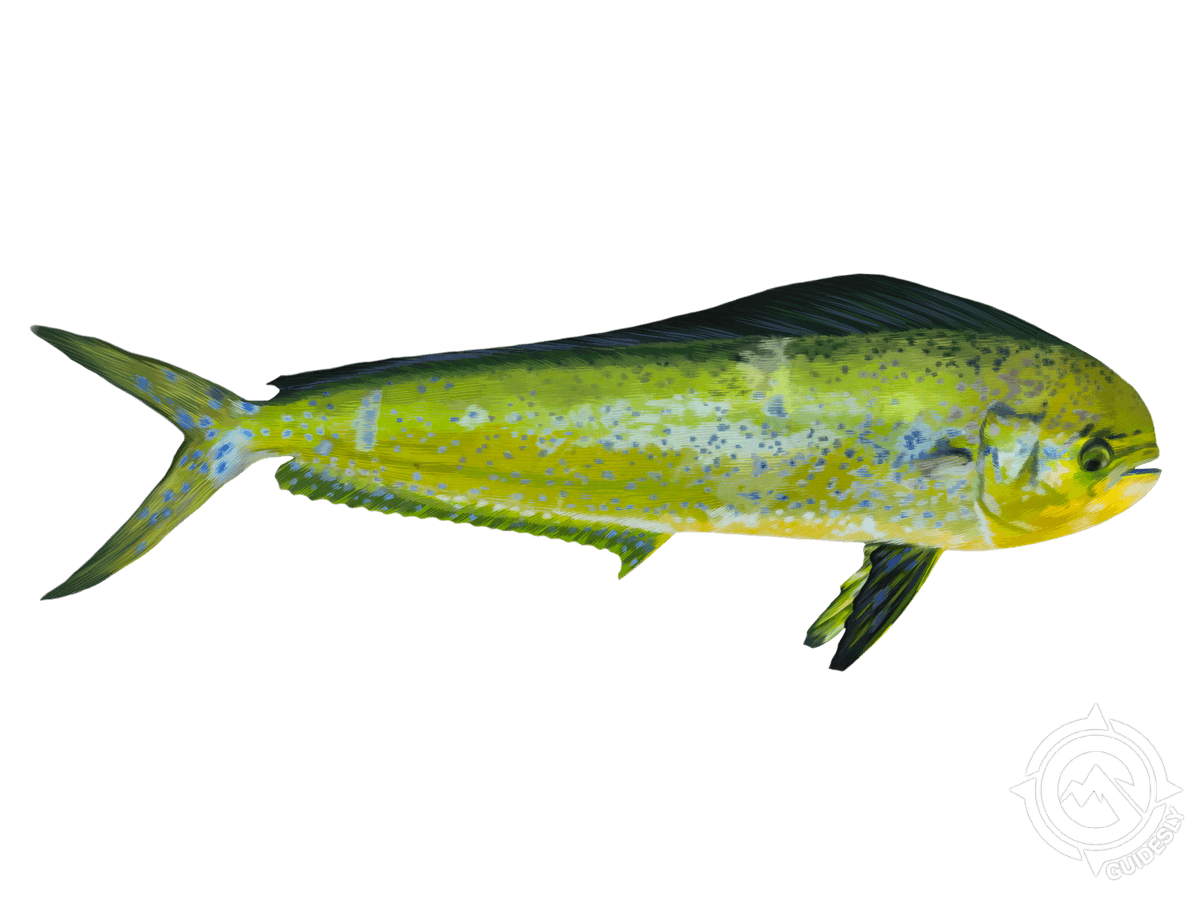
Yellowfin Tuna
Yellowfin Tuna (Thunnus Albacares) Description
The Yellowfin Tuna is a larger fish in the tuna species. It has a streamlined and torpedo-shaped body with bright yellow coloring on its tail, dorsal fin, and anal fin thus giving it its name. Along with the yellow color on their sides, they have dark metallic blue color on their backs and silver on their belly region. In an adult Yellowfin, the second dorsal and anal fins are large, extending back to the tail, and appear as crescents. It is a warm-blooded fish.
Size and Speed:
Yellowfin can be found weighing up to 440 pounds, but an angler is more likely to catch a 60-pounder. The body ranges from 2 to 7 feet. Due to their streamlined body, yellowfin tuna can move at an astonishing speed of 50 miles per hour.
Fun Facts
- The Yellowfin Tuna, or known by their other name, Ahi, is a prized fish in the Japanese fresh fish cuisine of sushi or sashimi. It also makes a great grilling steak.
- Although the Bluefin Tuna is considered the holy grail of fresh tuna because of its delicious fatty meat, the Yellowfin comes in at a close second in taste and is much cheaper and easier to find at the grocery or fish store.
- Bluefin is quickly picked up by high-end restaurants making Yellowfin more readily available at the fish market.
- Yellowfin Tuna are known as spawning and eating machines. They have a featured meshwork of tiny blood vessels around their muscles, making them warm-blooded.
Habitat:
Yellowfin tuna are commonly found in tropical and sub-tropical regions worldwide. They are most often found in the upper hundred meters of the water column. Yellowfin tuna are highly migratory; they travel large distances and even entire oceans.
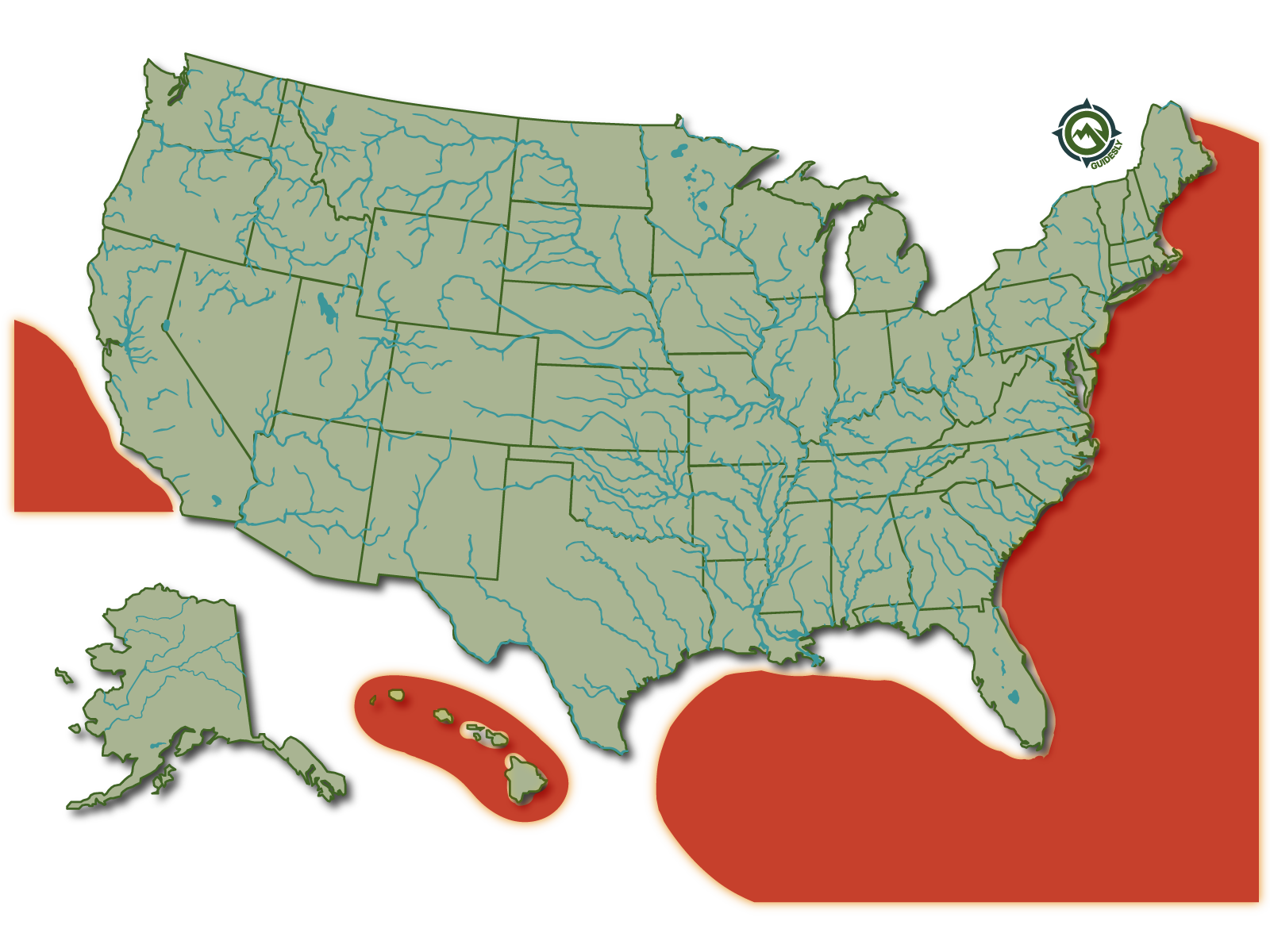
Fishing Techniques - How to Catch Yellowfin Tuna
Yellowfin Tuna are abundantly caught as offshore gamefish throughout the year. Different methods include trolling, casting, jigging, or drifting. Setting up a trolling spread can be a complicated business, but rigged ballyhoo, skirted trolling lures, cedar plugs, and spreader bars are a good place to start. When you’re marking fish down deep but nothing’s biting, sometimes it’s smart to bring in the spread and start jigging.
While trolling and jigging can be effective, nothing matches the excitement of a Yellowfin coming out of nowhere to annihilate a surface plug.
Fly fishing is not easy for yellowfin tuna. Popper and Tandem tube fly are best, but it can be hard to get a yellowfin tuna to commit to taking your fly.
Chunking is a technique that’s often used to draw the attention of a finicky tuna. It’s pretty straightforward, essentially cutting up dead bait and tossing it overboard to draw hungry tuna up from the depths. You’ll have the most success using whatever it is that the tuna are feeding on at that time of year in your location. Herring, menhaden, blue runners, and anchovies are all viable options.
Spawning:
This tuna spawns from May to August in the Gulf of Mexico and from July to November in the southeastern Caribbean.
Distribution and Habitat
Yellowfin tuna are native to the Pacific Ocean, Indian Ocean, and Atlantic ocean. They can be found as far north as Massachusetts in the summer.
They are found in the top 330 feet or pelagic zone of the water.
US Regulations
US Regulations Season - always open
Size limit - The Carolinas, Alabama, Louisiana, Mississippi - 27'' curved, FL minimum; other states have no size regulations.
Bag limit (per angler per day) - The Carolinas, Mississippi - 3; California has a 20 finfish bag limit, with no more than 10 fish of a single species allowed, other states have no relevant bag regulations;

About the Center Console Boats
%2F%2Fusers%2Faa5523c7-0c5c-4f78-912c-be69fe56c86c%2Fvehicle_picture%2Fimage64.png&w=1200&q=75)
Vehicle Guest Capacity: 4
Manufacturer Name: Yamaha
Maximum Cruising Speed: 40
Number of Engines: 2
Horsepower per Engine: 150
%2Ffit-in%2F250x250%2Fguide_websites%2F13763%2Fimages%2F1709855827067image66.png&w=1200&q=100)
%2Fusers%2Faa5523c7-0c5c-4f78-912c-be69fe56c86c%2Fimages%2Fbest-great-striped-bass-barnegat-2756.jpg&w=768&q=75)
%2Fusers%2Faa5523c7-0c5c-4f78-912c-be69fe56c86c%2Fimages%2Fstriped-bass-caught-barnegat-light-2704.jpg&w=768&q=75)
%2Fusers%2Faa5523c7-0c5c-4f78-912c-be69fe56c86c%2Fimages%2Fstriped-bass-barnegat-light-2680.jpg&w=768&q=75)
%2Fusers%2Faa5523c7-0c5c-4f78-912c-be69fe56c86c%2Fimages%2Fstriped-bass-barnegat-light-2658.jpg&w=768&q=75)
%2Fusers%2Faa5523c7-0c5c-4f78-912c-be69fe56c86c%2Fimages%2Fanglers-fishing-new-jersey-2892.jpg&w=768&q=75)
%2Fusers%2Faa5523c7-0c5c-4f78-912c-be69fe56c86c%2Fimages%2Ffishing-adventure-in-nj-2667.jpg&w=768&q=75)
%2Fusers%2Faa5523c7-0c5c-4f78-912c-be69fe56c86c%2Fimages%2Fsouthern-flounder-barnegat-light-2740.jpg&w=768&q=75)
%2Fusers%2Faa5523c7-0c5c-4f78-912c-be69fe56c86c%2Fimages%2Fanglers-fishing-new-jersey-2522.jpg&w=768&q=75)
%2Fusers%2Faa5523c7-0c5c-4f78-912c-be69fe56c86c%2Fimages%2Ffishing-at-barnegat-light-2502.jpg&w=768&q=75)
%2Fusers%2Faa5523c7-0c5c-4f78-912c-be69fe56c86c%2Fimages%2Fblackfin-tuna-barnegat-light-2703.jpg&w=768&q=75)
